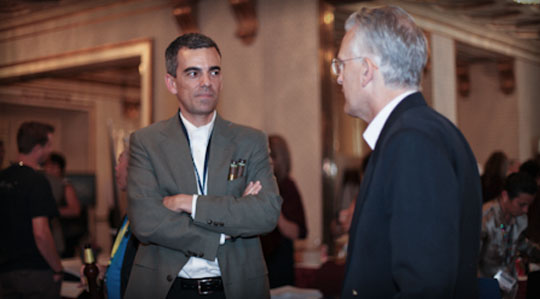100x
100x.
That was the title of my presentation to the CFA Society of Columbus last Wednesday. I spoke about some of the things I’ve learned in studying stocks that return 100-fold, those coveted 100-baggers.
And it was in that meeting that a crazy coincidence occurred.
In my presentation, I started by talking about Chuck Akre at Akre Capital Management. He’s a well-regarded investor. He ran FBR’s Focus Fund, which was a top-performing fund for many years. Then in 2009, he broke off on his own. His Akre Focus Fund has also done well, returning 17.5% annually, after fees, since inception.
Akre’s been in the securities business since 1968. He’s a wise bird. He’s also had a big impact on my investment thinking. In 2011, I read the transcript of a speech in which he talked about a book he read in 1972 and how it shaped his thinking.
That book was 100 to 1 in the Stock Market by Thomas Phelps. I read it soon after Akre’s speech, and it’s also had a big impact on my thinking.
So I opened my presentation with this anecdote, and I had a picture of Chuck Akre on my first slide. I didn’t know until I got there that someone from Akre Capital was going to speak after me.
Tom Saberhagen is a portfolio manager at Akre. And he told me that 100 to 1 in the Stock Market has long been one of Chuck’s favorite books on investing. Our respective presentations dovetailed very well. We had the same core message.
That message is that you should focus on how much a business earns on the money invested in it. The term of art is “return on capital.” And secondarily, you have to think about the ability of the firm to reinvest its cash flow at high rates of return.
Tom ran through a few examples in his speech. One of them was Apple.
Apple earns about 30% on its equity. That means for every $1 invested in Apple, it earns almost 30 cents. An investor who paid book value would, in theory, see a 30% return on his money.
But an investor can’t pay book today. The price today is 6 times book. So the implied return an investor gets is really 5%. That’s not so high.
Second, you have to consider Apple’s ability to reinvest its cash flow. It clearly generates more cash than it can reinvest at those 30% returns. So the cash piles up on its balance sheet and Carl Icahn and others call for Apple to return more of that cash to shareholders.
But as Tom pointed out, even if Apple paid out all of its earnings, investors would earn 5% pretax. That’s not much. It’d take 94 years to turn a 100-bagger at that rate. I realize high returns are hard to find in this market — and I’ve made few new stock picks as a result — but I aim to do better than that.
What Akre looks for is a company that can earn a high rate of return and can also reinvest all of its earnings at that return. That’s the ideal.
In Akre’s ideal investment, then, an investor would receive no dividend. But over time, if you buy the stock at a reasonable price, the stock should grow more or less in line with its return on capital and the growth in earnings. That will be higher — much higher — if a company pays no dividend and can reinvest it. (And the kicker is you enjoy the tax deferral on any gains.)
Phelps talks about this in his book and gives a simple example. Assume a company has $10 per share in book value and earns 15% on that capital and can reinvest all of its earnings and earn that rate. “In five years, the company’s book value will have doubled,” Phelps writes. “In 10 years, it will have quadrupled. In 33 years, it will be up 100-fold.”
But if the company had paid dividends, the story would be quite different. Say it paid out one-third of its earnings. It would then take 15 years to quadruple its capital, not 10. And in 33 years, it would be up 23-fold, instead of being a 100-bagger. Big difference.
Akre does not own Apple today. And Tom was not necessarily making a judgment on whether Apple is a good investment or not. He simply used it as a case study to illustrate how they think about stocks at Akre. It’s all about the return on capital and the ability to reinvest that return.
Afterward, I got to chat with Tom a bit about investing. We have a lot in common in our approaches. Tom invited me to visit Akre Capital in Middleburg, Virginia. I plan on visiting soon.
In a 1988 shareholder letter, Akre summed up his investment philosophy this way:
“We try to find great companies to invest in which will do well in nearly all environments. And when we buy shares in them, we do not fuss with them because we believe that they will improve and grow in value and that as time passes, that improvement in value will be reflected in the stock price.
The fewer investment decisions we make, the less exposure we have to making mistakes. Obviously, these decisions that are made must be correct, which is why we spend so much time trying to understand the quality of businesses.”
That’s good old-fashioned common-sense investing. And it’s what I try to do for you and my newsletter readers as well.
Regards,
Chris Mayer
The Daily Reckoning
P.S. We invited our subscribers to Baltimore to attend an event we’re hosting with Jim Rickards and a star-studded lineup. I’ll be there, too, presenting on my new 100-Baggers project. These are details you miss out on if you’re not subscribed to our email list, however. Signing up is free and the daily issues we send you are bound to become the most informative and entertaining 15 minutes of your day. Click here to sign up for the Daily Reckoning now.



Comments: